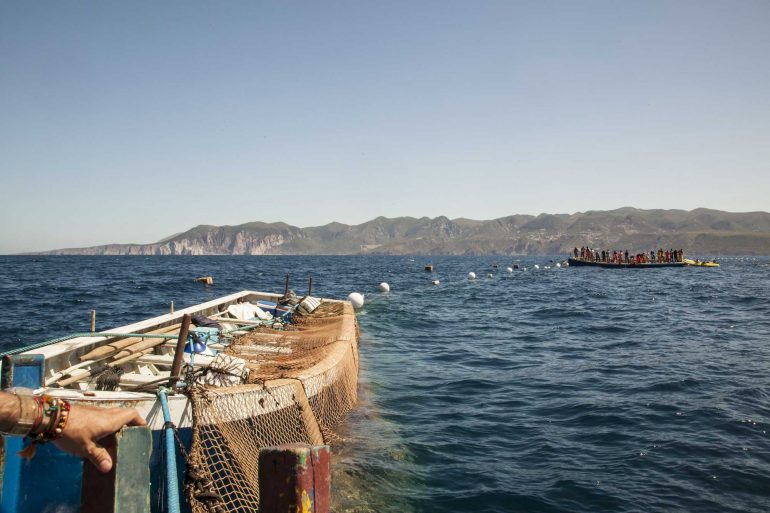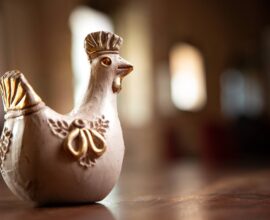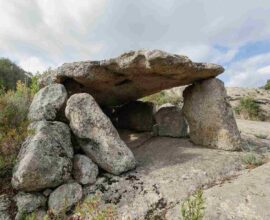La Tonnara di Carloforte
Tuna fishing in Sardinia is a millenary tradition: the first archaeological findings that testify the use of harpoons to catch tuna date back to the Nuragic civilization (about 2000 years before Christ). When we talk about Sardinian tuna, we cannot but think of the Carloforte tuna trap, the only tuna trap still active today in the Mediterranean where tuna is caught according to the ancient traditions.
The tuna fishing technique was introduced in the Mediterranean by the Arabs who spread it in Sicily and Sardinia. It is no coincidence that in the fishermen’s terminology (or rather of the tuna fishermen), there are many words of Arab origin, such as “rais”, the head of the tuna, which in Arabic means exactly boss or king.
How tuna fishing takes place in Carloforte
The tuna fishing method provides for a series of nets to be placed which form chambers that gradually shrink, pushing the schools of tuna to the last one called the “death chamber”, with a net also on the bottom that is hoisted to bring the tuna to the surface. At this point, the slaughter takes place, that is the actual capture of the tuna that are hoisted on board the boats that surround the chamber. Traditionally, the Carloforte tuna fishery takes place from the end of April to June, the time of the year when the tuna arrive from the Atlantic Ocean in the warmest waters of the Mediterranean to lay their eggs.
In April and May, fishing equipment is usually prepared and lowered in the sea, while the slaughter is normally held in June. Those who want can attend this event.
The slaughter is considered by many a particularly cruel fishing technique, but like many ancient and traditional fishing methods, it is far more environmentally friendly when compared to modern systems that use deep-sea fishing nets and sophisticated technologies to locate and catch shoals of fish. The number of tuna is being drastically reduced in all the seas of the world, and bluefin tuna, in particular, is now an endangered species due to extensive industrial fishing responding to growing market demand. Traditional traps, such as Carloforte’s, bear witness to a sustainable fishing method: unlike industrial fishing which indiscriminately destroys all species with large nets, the tuna is selected in the trap before being caught.
The prized Bluefin Tuna
The Red Tuna of Carloforte is considered the best in the world: its meat is particularly red, fat and tender. Even the Phoenicians appreciated its organoleptic qualities, attributed to its beneficial properties and consumed them as propitiatory food to celebrate weddings.
Today it is the favourite raw material of many Japanese sushi masters who do everything to get it fresh daily (if you have had tuna sushi in one of the most famous restaurants in Tokyo, it’s likely you ate Sardinia’s Bluefin Tuna).
The beauties of Carloforte
Carloforte is on the island of San Pietro, in the Sulcis archipelago, a few miles off the southwestern coast of Sardinia. A curiosity about this village is that it was founded by some Genoese families (originally from Pegli) who in 1783 obtained the right to colonize the island of San Pietro from King Carlo Emanuele III, and still today, the dialect spoken in Carloforte is not Sardinian but Genoese. The village is very charming with its alleys and multicoloured houses and has many historical buildings such as the church of Santa Maria del Naufrago and the ruins of the walls that originally surrounded the town to defend it from pirates. Don’t miss out on the multimedia museum of the Sea that holds the village’s story and its relationship with the sea and fishing.
Carloforte and the island of San Pietro are renowned for their beautiful beaches, surrounded by the Mediterranean maquis, such as Bobba, Punta Nera flanked by a suggestive cliff or the Beach of Guidi that can be reached on foot through a path in the bush.
How to get to Carloforte
Carloforte can be reached by ferry from Calasetta (on the island of Sant’Antioco) and from Portovesme, which is about 80km from Cagliari. The crossing takes 30/40 minutes, and the ferries depart with a frequency of about one hour throughout the day. From Portovesme you can also board cars.






